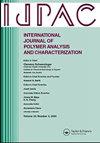Exploring the material and mechanical characteristics of 3D printed composites utilizing nSiO2-particulate-reinforced PLA/HDPE filaments with potential applications in the medical field
IF 1.7
4区 工程技术
Q4 POLYMER SCIENCE
International Journal of Polymer Analysis and Characterization
Pub Date : 2025-01-09
DOI:10.1080/1023666X.2024.2444320
引用次数: 0
Abstract
Significant progress in 3D printing technology over recent decades has allowed for the creation of biomedical products with enhanced properties. The incorporation of composite materials in 3D printing offers innovative solutions to a wide range of real-world challenges in medical applications. The present research focuses on the additively manufactured 3D-printed polymer composites developed through the fused deposition modeling technique. Mechanical characteristics such as tensile, compressive, flexural, and Shore D hardness have been investigated in pure PLA/HDPE and with different 1, 2, 3 wt.% of functionalized nSiO2 reinforced PLA/HDPE. Their results showed that excellent mechanical strength was observed in the 2 wt.% nSiO2/PLA/HDPE composite as 147.3 MPa tensile strength and 4.05 GPa Young's modulus. Subsequently, the material characteristics of the 2 wt.% nSiO2-reinforced composite were investigated with various analytical techniques. FESEM micrographs revealed that the developed composites with a rougher surface promoted cell attachment and proliferation and had no delaminated parts in the printed layer. EDAX analysis confirmed the reinforcement material nSiO2 particles present in the developed composite. The prominent sharp peaks of nSiO2 incorporated in the 3D-printed composite have an excellent crystallinity nature with 84.3%. The presence of nSiO2 reinforcement in the composite matrix was confirmed by FTIR and Raman spectroscopy. TGA/DTG results displayed the 7.36% high thermal stability of the nSiO2-reinforced composite. Thus, the developed composite was found to be a promising material for bone implants in biomedical applications.
求助全文
约1分钟内获得全文
求助全文
来源期刊
CiteScore
3.50
自引率
5.30%
发文量
37
审稿时长
1.6 months
期刊介绍:
The scope of the journal is to publish original contributions and reviews on studies, methodologies, instrumentation, and applications involving the analysis and characterization of polymers and polymeric-based materials, including synthetic polymers, blends, composites, fibers, coatings, supramolecular structures, polysaccharides, and biopolymers. The Journal will accept papers and review articles on the following topics and research areas involving fundamental and applied studies of polymer analysis and characterization:
Characterization and analysis of new and existing polymers and polymeric-based materials.
Design and evaluation of analytical instrumentation and physical testing equipment.
Determination of molecular weight, size, conformation, branching, cross-linking, chemical structure, and sequence distribution.
Using separation, spectroscopic, and scattering techniques.
Surface characterization of polymeric materials.
Measurement of solution and bulk properties and behavior of polymers.
Studies involving structure-property-processing relationships, and polymer aging.
Analysis of oligomeric materials.
Analysis of polymer additives and decomposition products.

 求助内容:
求助内容: 应助结果提醒方式:
应助结果提醒方式:


